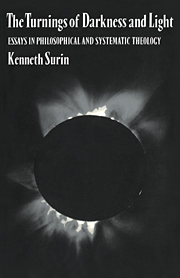Book contents
- Frontmatter
- Contents
- Dedication
- Preface
- Abbreviations
- 1 Creation, revelation and the analogy theory
- 2 The Trinity and philosophical reflection: a study of David Brown's The Divine Trinity
- 3 ‘Is it true what they say about “theological realism”?’
- 4 The impassibility of God and the problem of evil
- 5 Theodicy?
- 6 Tragedy and the soul's conquest of evil
- 7 Atonement and moral apocalypticism: William Styron's Sophie's Choice
- 8 Atonement and christology
- 9 Revelation, salvation, the uniqueness of Christ and other religions
- 10 ‘Many religions and the one true faith’: an examination of Lindbeck's chapter 3
- 11 Contemptus mundi and the disenchanted world: Bonhoeffer's ‘discipline of the secret’ and Adorno's ‘strategy of hibernation’
- 12 ‘The weight of weakness’: intratextuality and discipleship
- 13 ‘Theistic arguments’ and ‘rational theism’
- Notes
- Index of names
- Index of subjects
7 - Atonement and moral apocalypticism: William Styron's Sophie's Choice
Published online by Cambridge University Press: 19 January 2010
- Frontmatter
- Contents
- Dedication
- Preface
- Abbreviations
- 1 Creation, revelation and the analogy theory
- 2 The Trinity and philosophical reflection: a study of David Brown's The Divine Trinity
- 3 ‘Is it true what they say about “theological realism”?’
- 4 The impassibility of God and the problem of evil
- 5 Theodicy?
- 6 Tragedy and the soul's conquest of evil
- 7 Atonement and moral apocalypticism: William Styron's Sophie's Choice
- 8 Atonement and christology
- 9 Revelation, salvation, the uniqueness of Christ and other religions
- 10 ‘Many religions and the one true faith’: an examination of Lindbeck's chapter 3
- 11 Contemptus mundi and the disenchanted world: Bonhoeffer's ‘discipline of the secret’ and Adorno's ‘strategy of hibernation’
- 12 ‘The weight of weakness’: intratextuality and discipleship
- 13 ‘Theistic arguments’ and ‘rational theism’
- Notes
- Index of names
- Index of subjects
Summary
Introductory
In this essay I shall be discussing William Styron's depiction of a theologically significant incident in his novel Sophie's Choice (London: Corgi Books, 1979). Since our discussion will approach the novel from a theological as opposed to a purely ‘literary’ standpoint, it behoves us to begin by specifying the theological context of the argument we hope to develop in this essay. This essay is concerned with that area of theological reflection which traditionally goes under the rubric of the doctrine of the atonement. More specifically: we shall argue that Styron's narration of the episode which gives his book its title provides a basis for a criticism of all purely ‘subjective’ interpretations of the atonement. The adherent of a purely ‘subjective’ conception of the atonement emphasizes the manner in which the believer makes the work of Christ her own – the saving significance of Christ's work is reckoned by the ‘subjectivist’ to lie in the ways in which individuals appropriate that work. That is to say, Christ's saving work takes the form of a ‘subjective’ process; it is, in the words of Donald Baillie (a notable modern proponent of the ‘subjective’ conception), a ‘reconciling of us to God through a persuasion in our hearts that is … a realizing of his eternal love’.
‘Subjective’ understandings of the atonement have come to prevail in recent years. This is mainly because ‘objective’ conceptions are invariably bound up with ‘incarnational’ christologies, and ‘incarnational’ christologies no longer totally dominate the theological consensus.
- Type
- Chapter
- Information
- The Turnings of Darkness and LightEssays in Philosophical and Systematic Theology, pp. 102 - 116Publisher: Cambridge University PressPrint publication year: 1989

